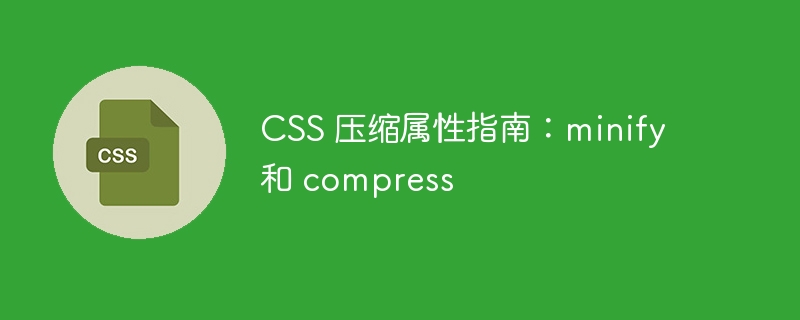CSS compression property guide: minify and compress

CSS compression property guide: minify and compress, specific code examples required
In front-end development, optimizing web page performance is a key task. Effectively optimizing CSS code can greatly improve the loading speed and user experience of your web pages. And compressing CSS is a common optimization technique that can reduce file size and increase page load speed. In this article, we will learn how to use minify and compress, two commonly used CSS compression properties, and provide specific code examples.
- minify property
The minify property of CSS is used to streamline CSS code, remove unnecessary spaces, newlines, and comments, and compress the code into one line. This compression method can effectively reduce file size, but it can make the code difficult to read and maintain. The following is an example code for compressing CSS using the minify attribute:
/* 原始 CSS 代码 */
body {
background-color: #f1f1f1;
color: #333;
font-size: 16px;
}
h1 {
color: #ff0000;
font-size: 24px;
}
/* 压缩后的 CSS 代码 */
body{background-color:#f1f1f1;color:#333;font-size:16px;}h1{color:#ff0000;font-size:24px;}In the above code example, the original CSS code contains multiple spaces and newlines, and the compressed code is compressed into One line, with unnecessary spaces and newlines removed. As you can see, the compressed code is more compact and the file size is reduced a lot.
- compress attribute
The compress attribute of CSS is similar to the minify attribute and is also used to compress code. The difference is that the compress attribute will further compress and optimize the code, removing useless CSS rules and declarations. The following is a sample code that uses the compress attribute to compress CSS:
/* 原始 CSS 代码 */
body {
background-color: #f1f1f1;
color: #333;
font-size: 16px;
}
h1 {
color: #ff0000;
font-size: 24px;
}
p {
color: #000;
font-size: 14px;
line-height: 1.5;
}
/* 压缩后的 CSS 代码 */
body{background:#f1f1f1;color:#333}h1{color:#f00}p{color:#000;line-height:1.5}In the above code sample, the original CSS code contains multiple CSS rules and declarations, and the compressed code removes useless CSS rules and declarations, and simplified color values, etc. The compressed code is more streamlined, reducing file size and load time.
Summary:
Compressing CSS is an effective method when optimizing web page performance. By using the minify and compress CSS compression properties, you can compress and streamline your CSS code, reducing file size and increasing page load speed. However, it should be noted that using compression attributes may affect the readability and maintainability of the code, so code compression and maintenance costs need to be weighed in actual development. I hope this article helps you understand and apply CSS compression properties!
The above is the detailed content of CSS compression property guide: minify and compress. For more information, please follow other related articles on the PHP Chinese website!

Hot AI Tools

Undresser.AI Undress
AI-powered app for creating realistic nude photos

AI Clothes Remover
Online AI tool for removing clothes from photos.

Undress AI Tool
Undress images for free

Clothoff.io
AI clothes remover

AI Hentai Generator
Generate AI Hentai for free.

Hot Article

Hot Tools

Notepad++7.3.1
Easy-to-use and free code editor

SublimeText3 Chinese version
Chinese version, very easy to use

Zend Studio 13.0.1
Powerful PHP integrated development environment

Dreamweaver CS6
Visual web development tools

SublimeText3 Mac version
God-level code editing software (SublimeText3)

Hot Topics
 1386
1386
 52
52
 Working With GraphQL Caching
Mar 19, 2025 am 09:36 AM
Working With GraphQL Caching
Mar 19, 2025 am 09:36 AM
If you’ve recently started working with GraphQL, or reviewed its pros and cons, you’ve no doubt heard things like “GraphQL doesn’t support caching” or
 Building an Ethereum app using Redwood.js and Fauna
Mar 28, 2025 am 09:18 AM
Building an Ethereum app using Redwood.js and Fauna
Mar 28, 2025 am 09:18 AM
With the recent climb of Bitcoin’s price over 20k $USD, and to it recently breaking 30k, I thought it’s worth taking a deep dive back into creating Ethereum
 Vue 3
Apr 02, 2025 pm 06:32 PM
Vue 3
Apr 02, 2025 pm 06:32 PM
It's out! Congrats to the Vue team for getting it done, I know it was a massive effort and a long time coming. All new docs, as well.
 Can you get valid CSS property values from the browser?
Apr 02, 2025 pm 06:17 PM
Can you get valid CSS property values from the browser?
Apr 02, 2025 pm 06:17 PM
I had someone write in with this very legit question. Lea just blogged about how you can get valid CSS properties themselves from the browser. That's like this.
 A bit on ci/cd
Apr 02, 2025 pm 06:21 PM
A bit on ci/cd
Apr 02, 2025 pm 06:21 PM
I'd say "website" fits better than "mobile app" but I like this framing from Max Lynch:
 Comparing Browsers for Responsive Design
Apr 02, 2025 pm 06:25 PM
Comparing Browsers for Responsive Design
Apr 02, 2025 pm 06:25 PM
There are a number of these desktop apps where the goal is showing your site at different dimensions all at the same time. So you can, for example, be writing
 Using Markdown and Localization in the WordPress Block Editor
Apr 02, 2025 am 04:27 AM
Using Markdown and Localization in the WordPress Block Editor
Apr 02, 2025 am 04:27 AM
If we need to show documentation to the user directly in the WordPress editor, what is the best way to do it?
 Stacked Cards with Sticky Positioning and a Dash of Sass
Apr 03, 2025 am 10:30 AM
Stacked Cards with Sticky Positioning and a Dash of Sass
Apr 03, 2025 am 10:30 AM
The other day, I spotted this particularly lovely bit from Corey Ginnivan’s website where a collection of cards stack on top of one another as you scroll.




